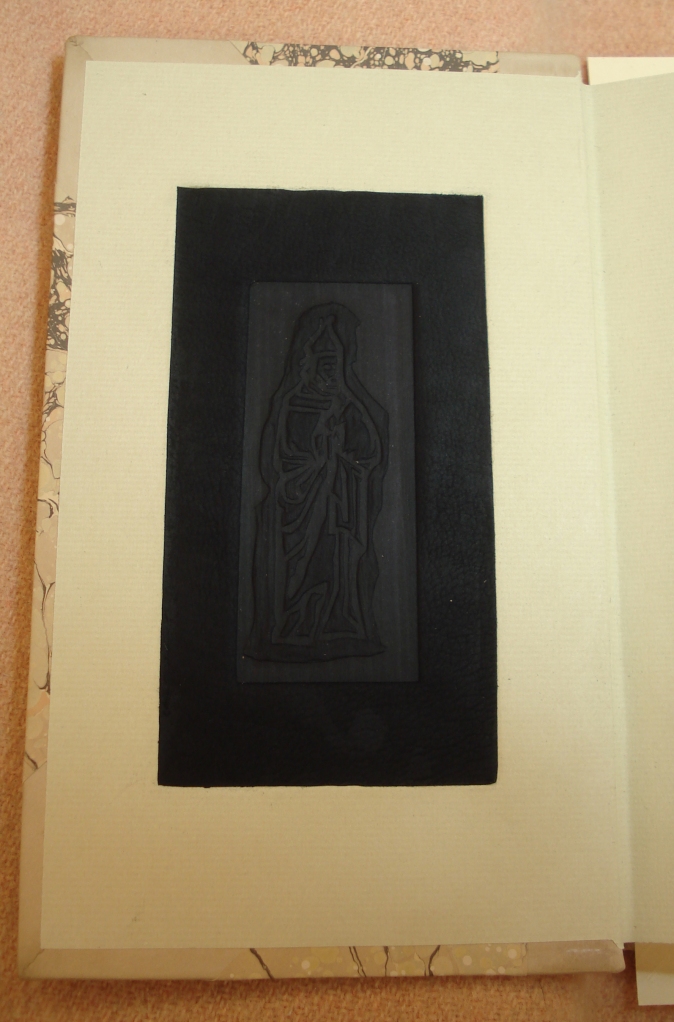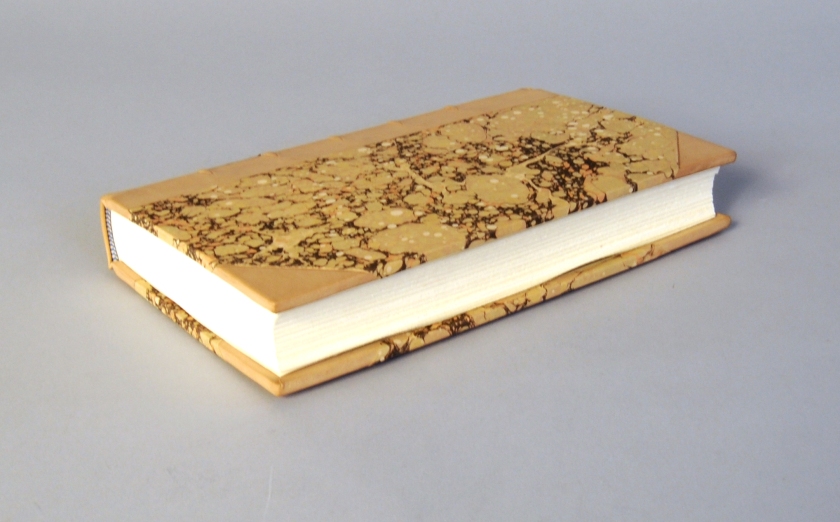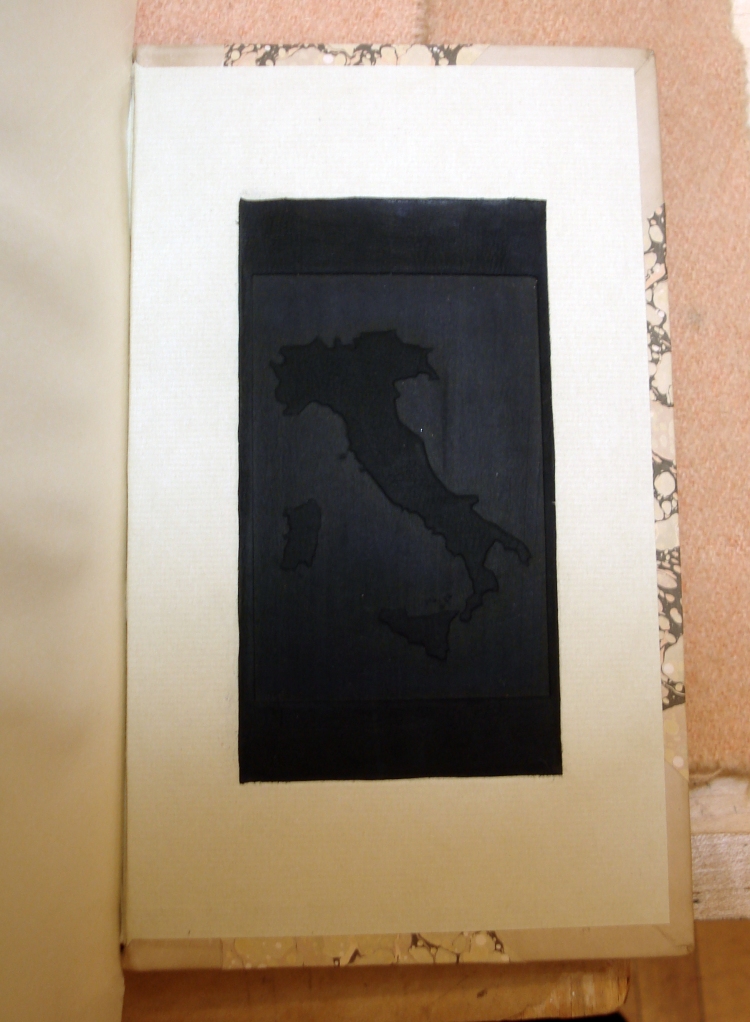In the spring of this past year, I was asked by a friend to create a nice binding for a copy of St. Augustine of Hippo’s Confessions. He had an idea for a traditional looking binding with more modern design elements, and working together, we came up with this:
The forwarding is essentially the same as the 18th century trade binding I described in my last post: sewn on five single raised supports, undecorated edges, and two color sewn endbands.
The spine and corners of the binding are covered in undyed calfskin and the siding-up is a stone pattern marbled paper that I created during the workshop with the St. John’s. The finishing is very simple: blind tooling on the spine and faces of the boards, and a brown goatskin lettering piece, done with handle letters.
In order to do this binding, I needed an edition that was composed of sewn sections, rather adhesive-bound sheets. We found a modern Knopf printing that looked nice and was suitable.
This binding was intended as a gift, to be given during a tour through Italy. Working collaboratively, we created a design that would make the book unique and document the trip. The insides of the boards feature blue calfskin panels, pressed with woodblocks and tooled with palladium. St. Augustine appears on the inside of the front board, while the back board shows a map of Italy with the location of each stop on the trip marked in silver dots. I’ll describe how the panels were made below. At the time, I did not know how to do doublures or leather hinges, so my method is probably a bit odd.
As I was making up the boards, I built a well into the inside of each.
After covering and trimming out, I adhered the pastedowns, carefully working the paper into sides of the well. In a tight-joint binding in which the pastedown and flyleaf are composed of paper with no additional leather hinge, the pastedown will come up short along the fore-edge. This gives an uneven appearance, since the visible turn-in (i.e. the square) on the fore-edge is much larger than those at head and tail. To compensate for this, I trimmed the head and tail of the pastedown so that the squares would match with the fore-edge. The cut goes to about a board thickness away from the joint and the transition is mitered at a 45 degree angle. This allows the full length of the endsheet to go over the joint, while leaving a neat transition. What I have described is most visible at the tail part of the joint in the above photo.
My friend is an accomplished woodworker, so he carved the woodblocks for the front and back board, drawing inspiration from depictions of St. Augustine.

St. Augustine by Piero della Francesca (1454), Museu Nacional de Arte Antiga, Lisbon
A basswood block, shorter and narrower than the wells, was cut in shallow relief. The blue calfskin was flat pared so that it was thinner than the depth of the well – I did not want it to sit proud of the board surface when done. It was then dampened, pasted up, and worked into the well. While the leather was wet, I simply aligned the woodblock and gently pressed it into the leather using a nipping press.
 I got the idea from Katherine Beaty’s presentation on Islamic bindings at last year’s GBW Standards meeting (see her handout here). I repeated the process for the map of Italy on the back board.
I got the idea from Katherine Beaty’s presentation on Islamic bindings at last year’s GBW Standards meeting (see her handout here). I repeated the process for the map of Italy on the back board.
When dry, I added some tooled lines at the edges of the leather in palladium and also marked the stops on the trip with tooled dots. I was very pleased with the way the woodcuts came out on the leather. The calfskin takes the grain of the wood beautifully, and after polishing the surface a bit with a heated iron, these panels really look great. My only complaint in this binding is the edge between the paper pastedown and leather panel; I wished it could have been a bit cleaner. If I was going to do this again, I would forego the paper and do it as a sunken doublure. I did not know how to do doublures at the time, so it couldn’t really be helped. I will definitely be using woodblocks for future bindings, however.
Ω
It is time to wrap up and say goodbye to 2012. This has not been the easiest year for me personally, but I learned a great deal and got to work with some very talented folks. Quetzalcoatl didn’t rise up and destroy the world either, so I think overall we can judge it a successful year. In this moment, I’m feeling setup for a pretty great 2013 – in a couple weeks I will be moving to the Midwest and starting a new job. I am sure that I will have plenty of material from my upcoming adventures to share here .
Wishing you and yours a safe and pleasant New Year!







I wish you and yours much success in your new endeavors and new location. Thank you for sharing your learning with us.
I must confess I am a silent observer of your blog, but I’m waiting with excitement for every new post. It is an honor to read and learn from you. Thank you so much for sharing your experience. Have a wonderful and successful 2013!